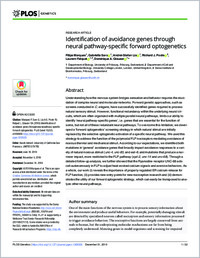Identification of avoidance genes through neural pathway-specific forward optogenetics
- Marques, Filipe Department of Biology, University of Fribourg, Fribourg, Switzerland
- Saro, Gabriella Department of Biology, University of Fribourg, Fribourg, Switzerland
- Lia, Andrei-Stefan Department of Biology, University of Fribourg, Fribourg, Switzerland
- Poole, Richard J. Department of Cell and Developmental Biology, University College London, London, United Kingdom
- Falquet, Laurent Department of Biology, University of Fribourg, Fribourg, Switzerland - Swiss Institute of Bioinformatics, Fribourg, Switzerland
- Glauser, Dominique A. Department of Biology, University of Fribourg, Fribourg, Switzerland
- 31.12.2019
Published in:
- PLOS Genetics. - 2019, vol. 15, no. 12, p. e1008509
English
Understanding how the nervous system bridges sensation and behavior requires the elucidation of complex neural and molecular networks. Forward genetic approaches, such as screens conducted in C. elegans, have successfully identified genes required to process natural sensory stimuli. However, functional redundancy within the underlying neural circuits, which are often organized with multiple parallel neural pathways, limits our ability to identify ‘neural pathway-specific genes’, i.e. genes that are essential for the function of some, but not all of these redundant neural pathways. To overcome this limitation, we developed a ‘forward optogenetics’ screening strategy in which natural stimuli are initially replaced by the selective optogenetic activation of a specific neural pathway. We used this strategy to address the function of the polymodal FLP nociceptors mediating avoidance of noxious thermal and mechanical stimuli. According to our expectations, we identified both mutations in ‘general’ avoidance genes that broadly impact avoidance responses to a variety of natural noxious stimuli (unc-4, unc-83, and eat-4) and mutations that produce a narrower impact, more restricted to the FLP pathway (syd-2, unc-14 and unc-68). Through a detailed follow-up analysis, we further showed that the Ryanodine receptor UNC-68 acts cell-autonomously in FLP to adjust heat-evoked calcium signals and aversive behaviors. As a whole, our work (i) reveals the importance of properly regulated ER calcium release for FLP function, (ii) provides new entry points for new nociception research and (iii) demonstrates the utility of our forward optogenetic strategy, which can easily be transposed to analyze other neural pathways.
- Faculty
- Faculté des sciences et de médecine
- Department
- Département de Biologie
- Language
-
- English
- Classification
- Biological sciences
- License
-
License undefined
- Identifiers
-
- RERO DOC 329820
- DOI 10.1371/journal.pgen.1008509
- Persistent URL
- https://folia.unifr.ch/unifr/documents/309111
Statistics
Document views: 119
File downloads:
- pdf: 163
